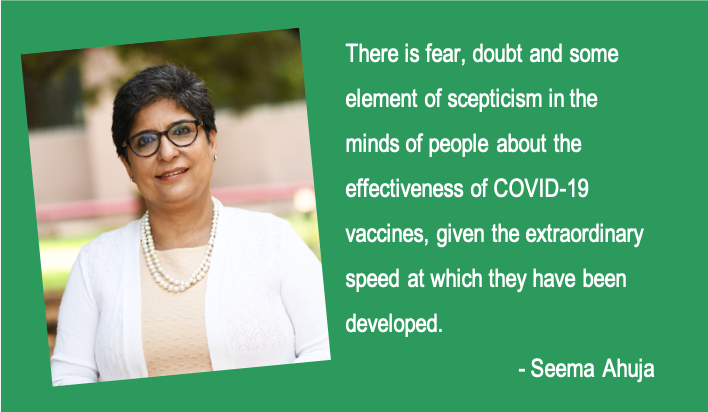On February 15, India crossed the one-month mark for the first phase of its COVID-19 vaccination drive. While the government is aiming to inoculate 300 million people across the country by August, data shows 8.3 million have received the vaccine as of February 15, 2021.
This indicates on an average almost 3 lakh people are being inoculated every day against the original target of 13 lakh per day. Is this a sign for worry?
I think it is, given that we have a population of 1.38 billion. More so, the government is aiming to inoculate 10 million health workers, 20 million frontline workers and 270 million people aged above 50 and those with comorbidities in the first phase of the drive. That’s a humongous task and the current trend shows it’s not going to be easy.
There is fear, doubt and some element of scepticism in the minds of people about the effectiveness of COVID-19 vaccines given the extraordinary speed at which they have been developed. This along with the fear of the unknown side effects are keeping many healthcare workers away from getting vaccinated. As a result, only one in 10 healthcare workers had taken the second dose of the vaccine on Feb. 13.
This initial experience with the healthcare workers indicates that the government is likely to encounter a much higher level of resistance and ‘vaccine hesitancy’ in the second phase of mass inoculation.
We have experienced similar trends in the past during polio, diphtheria and measles and rubella vaccines initiatives on account of misconceptions and misinformation. Unfortunately for the COVID-19 vaccine, the level of misinformation is multi-fold. This can only be addressed through an effective, mass scale, integrated Communication Campaign that the government needs to prioritise.
An integrated communications strategy
Customised communication with targeted messaging for diverse groups of people is very crucial. An effective mass media campaign, led by celebrity endorsements with participation from real healthcare workers, can go a long way in influencing people’s behaviour and overcoming ‘vaccine hesitancy’.
We should remember that the success of polio vaccination in India had a lot to do with a well-planned, high-decibel communications campaign involving advertising veteran Piyush Pandey and celebrities like actor Amitabh Bachchan, who was roped in as the brand ambassador for the Pulse Polio program in India.
A Comprehensive Communications Plan
To devise and implement a successful public outreach program several boxes will need to be ticked.
1. Communicate Proactively
The communication strategy needs to be integrated into the planning of the vaccination campaign right at the beginning. In the age of social media, the failure to communicate the right messages at the outset can lead to breeding of misinformation and ‘fake news’ about the dangers of taking the COVID-19 vaccine.
Israel, which had seen initial success in vaccinating its population against the novel coronavirus, experienced a slowdown in the campaign because of the spread of online misinformation. This led the Israeli Health Ministry to set up a digital task force to counter vaccine-related fake news.
2. Establish Trust
For effective communication, it is important to identify the target audience and frame messages that address their concerns and promote trust. The communication must provide a balanced view of the risks and benefits of vaccination for people to make informed decisions.
Research has shown that individuals can feel threatened and react defensively when faced with information that contradicts their values. This then reduces the likelihood of undergoing vaccination.
At the grassroots level, ASHA workers need to be involved in awareness creation as they enjoy a certain level of trust among the communities they serve. Mobilising populations through community leaders can also prove to be effective in promoting vaccination efforts.
3. Use communication tools wisely
The government today has a wide range of communication channels electronic mass media, social & digital media, print publications, mobile technology at its disposal. These channels need to be used basis of the target group and the messaging.
Social media needs to be leveraged with care. Vietnam was able to effectively fight the spread of the coronavirus last year thanks to a very successful social media campaign that involved a viral TikTok video of young people performing hand-washing dance moves as recommended by healthcare professionals. The video was tagged with the government-issued hashtag #ghencovychallenge and was viewed millions of times
4. Get Public Figures Involved
Roping in public figures to show that administering the COVID-19 vaccine is both safe and effective is a good communications strategy. Going ahead, the government can get celebrities and politicians to use their social media platforms to share their own experiences of receiving the COVID-19 shot. These public figures can act as ‘role models’ in spreading awareness on the importance of getting vaccinated and encouraging their followers and supporters to do so as soon as they can.
5. Use visual aids
The use of visual aids like infographics or video in the process of communication can help to make it effective and fruitful as they enhance a person’s understanding of complex information. Studies have shown that visual aids help people understand and assess health risks better.
Conclusion
India needs to prioritize its Public Communication Campaign and Citizens Engagement to create a positive mindset about vaccination, earning the trust of its people. This program needs to supplement the current communication campaigns aimed at creating awareness on Best Preventive Practices aimed at reducing the spread of the coronavirus. The Vaccination Communication program must be implemented in a mission- mode to ensure a significant section of our population is protected through vaccination, in the shortest possible time, if we want to turn the tide against this deadly novel coronavirus.
*The views expressed in the post above, are personal and not of the employer.
The views and opinions published here belong to the author and do not necessarily reflect the views and opinions of the publisher.



A thought through and well articulated article. Above all, very timely!